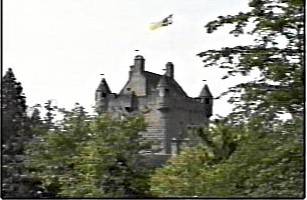|
Where is Cawdor Castle
12 miles east of Inverness, between Inverness and Nairn
on the B9090 off the A96
The home of Lord and Lady Cawdor, the castle and grounds
are open from May to October
History of Cawdor Castle
Cawdor had been an ancient Thanedom (Earldom) long before
the castle was built. Set in wooded grounds, the present buildings date
from the early 14th century. An entry in the Exchequer Rolls for 1398
refers to an outlay on `Calder Castle'. The castle and its owners enjoyed
that lawlessness that is associated with the Highlands, both the 4th
and 11th Thanes were murdered
In 1454 the Thane of Calder received a royal license
to build a new castle. The legend is set loose a donkey with a sack
of gold on its back, and that he would build his castle when the animal
wherever it first stopped to rest. The animal stopped under a holly
tree above the burn. The castle was built around the tree, which can
still be seen in the vaulted cellar of the keep The Cawdor Toast
is 'Flourish the Thorn!'
The present keep dates from 1454, and is typical of
15th century Scottish architecture
The entrance door, has a huge iron bolt across it, which
came from nearby Lochindorb Castle around 1455 when the Thane of Cawdor
was instructed to dismantle Lochindorb after it had been forfeited by
the Earl of Moray.
- When the 8th Thane of Cawdor died, his heir was an
infant daughter Muriel
- The king had apparently granted to the Earl of Argyll
the right to decide whom Muriel would marry. A party of Campbells
were sent to snatch the little girl. Tradition holds that her mother
branded her with a key and her nurse bit off the tip of her finger
for identification.
- She was married off to the Earls third son at the
age of 11, but the marriage was a happy one, and when her husband
died she returned to Cawdor as Thane. She died in about 1575 having
produced numerous children.
- In about 1660 Sir Hugh Campbell, Thane of Cawdor,
extensively remodelled the castle
- For several generations the family spent most of
their lives in Wales after one of them had married an heiress of lands
there in the 18th century.
- The Welsh lands have now been sold and the family
have returned to Cawdor as their home.
- In 1976 a hidden trap door was found in the drawing
room, which could dispatch any unwelcome visitor straight down a chute
carved within the thickness of the castle wall and into a dungeon
which has no other means of entry or exit.
- Two ghosts are said to haunt the premises, one a
lady in a blue velvet dress, the other is thought to be John Campbell,
the first Lord Cawdor.
|
